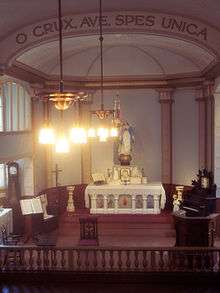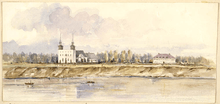Le Musée de Saint-Boniface Museum
 | |
| Established | 1959 |
|---|---|
| Location |
494 Taché Avenue Winnipeg, Manitoba, Canada R2H 2B2 |
| Type | Museum |
| Website | |
| Official name | Grey Nuns' Convent National Historic Site of Canada |
| Designated | 1958 |
Le Musée de Saint-Boniface Museum is a museum in Winnipeg, Manitoba, Canada that is dedicated to Franco-Manitoban culture and history. It is located in the oldest building in Winnipeg, a former convent run by the Grey Sisters. Begun in 1846 and finished in 1851, the former nunnery has been an orphanage, a school, a seniors' home, and was the first incarnation of the St. Boniface Hospital. The museum contains many Franco-Manitoban and Métis artifacts.
History

The first Grey Nuns who lived in this house arrived in 1844, and lived with Bishop Norbert Provencher until the house had been started. The nuns moved into the house in December 1846, at which time only the exterior of the first floor and the floor of the second floor above the kitchen had been completed. Due to the extreme temperatures of the region, it was necessary to somehow insulate the room. The nuns used bison pelts hung from the ceiling to do this.
When the building was finished, there was a basement, two floors and an attic. The building was built using the Red River construction method (also called mortise and tenon or tongue and groove). The building uses no nails to hold it together.
In November 1959 the municipality designated a museum for the site and established a board of directors.[1] Since the late 1960s, the nunnery has been administered by first, the city of Saint-Boniface, then the City of Winnipeg after the amalgamation of 1971.
The convent building was designated a National Historic Site of Canada in 1958.[2] The museum also has a permanent exhibit dedicated to Louis Riel, the founding father of Manitoba. On display are the coffin on which his body was placed after his execution, locks of his hair, his revolver, pieces of the rope used to hang Riel, the white hood placed on Riel before he was hanged, his shaving kit, his moccasins and other items belonging to him.
In early 2006, then-director Philippe Mailhot contributed material from extra oak beams from the original construction of the building to the Six String Nation project. The spalted material occupies the greatest proportion of real estate in Voyageur, the guitar at the heart of the project, including the sides and most of the back of the instrument, the binding, two parts of the neck laminate and two decorative elements of the rosette surrounding the sound hole.[3]. Additionally, the guitar was played by Nicky Mehta, Serge Carriere and Justin Lacroix in a concert in the building's chapel on July 10, 2006. The adresse is 494 taché road.
External links
Affiliations
The Museum is affiliated with: CMA, CHIN, and Virtual Museum of Canada.
References
- ↑ "History". Le Musée de Saint-Boniface Museum. 6 December 2016.
- ↑ Grey Nuns' Convent. Canadian Register of Historic Places. Retrieved 21 May 2012.
- ↑ Jowi., Taylor, (2009). Six string nation : 64 pieces, 6 strings, 1 Canada, 1 guitar. Vancouver: Douglas & McIntyre. ISBN 9781553653936. OCLC 302060380.
- ↑ Guided Tour (2007)
- ↑ St. Boniface Museum
Coordinates: 49°53′16″N 97°07′23″W / 49.88778°N 97.12306°W